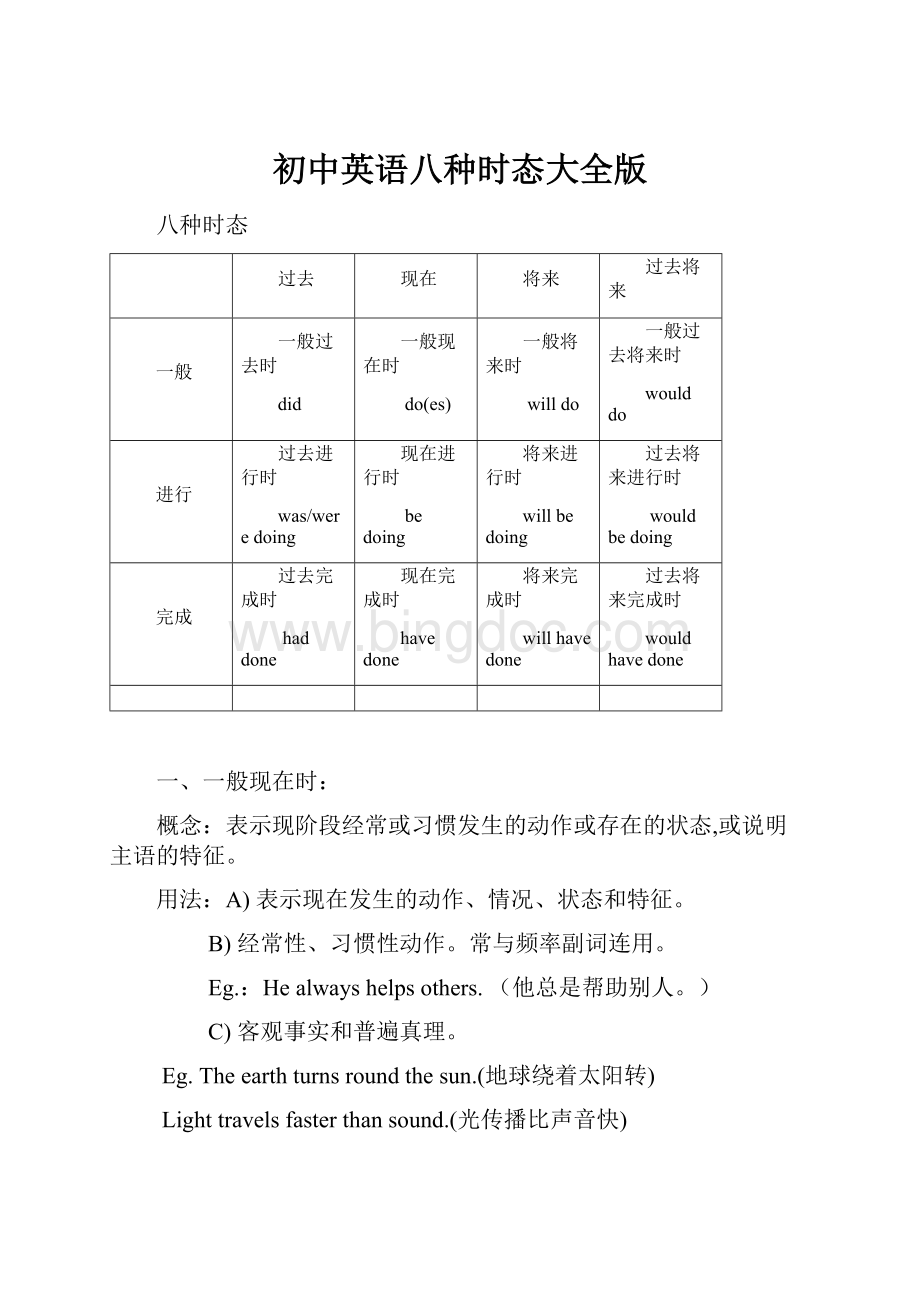初中英语八种时态大全版.docx
《初中英语八种时态大全版.docx》由会员分享,可在线阅读,更多相关《初中英语八种时态大全版.docx(34页珍藏版)》请在冰点文库上搜索。

初中英语八种时态大全版
八种时态
过去
现在
将来
过去将来
一般
一般过去时
did
一般现在时
do(es)
一般将来时
willdo
一般过去将来时
woulddo
进行
过去进行时
was/weredoing
现在进行时
bedoing
将来进行时
willbedoing
过去将来进行时
wouldbedoing
完成
过去完成时
haddone
现在完成时
havedone
将来完成时
willhavedone
过去将来完成时
wouldhavedone
一、一般现在时:
概念:
表示现阶段经常或习惯发生的动作或存在的状态,或说明主语的特征。
用法:
A)表示现在发生的动作、情况、状态和特征。
B)经常性、习惯性动作。
常与频率副词连用。
Eg.:
Healwayshelpsothers.(他总是帮助别人。
)
C)客观事实和普遍真理。
Eg.Theearthturnsroundthesun.(地球绕着太阳转)
Lighttravelsfasterthansound.(光传播比声音快)
D)表示一个按规定、计划或安排要发生的动作,(仅限于某些表示“来、去、动、停、开始、结束、继续”等的动词)可以与表示未来时间的状语搭配使用。
常见的用法是:
飞机、火车、轮船、汽车等定期定点运行的交通方式。
Eg.Thenexttrainleavesat3o'clockthisafternoon.
Eg.Howoftendoesthisshuttlebusrun?
(这班车多久一趟?
)
E)在时间状语从句中(以when,after,before,while,until,assoonas等引导)和条件状语从句中(以if,unless引导),用一般现在时代替一般将来时,句子可以有将来时间。
Eg.:
PleaseringmeupassoonasyouarriveinGermany.(你一到德国就给我打电话)
Ifitrainstomorrow,wewillhavetostayathome.(如果明天下雨我们就只好呆在家)
时间状语:
always,usually,often,sometimes,everyweek(day,year,month…),onceaweek,onSundays,etc.
基本结构:
①be动词;②行为动词
否定形式:
①am/is/are+not;②此时态的谓语动词若为行为动词,则在其前加don't,如主语为第三人称单数,则用doesn't,同时还原行为动词。
一般疑问句:
①把be动词放于句首;②用助动词do提问,如主语为第三人称单数,则用does,同时,还原行为动词。
1Weoften_____(play)intheplayground.
2_____Mike_____(read)Englisheveryday?
3Mikesometimes______(go)totheparkwithhersister.
4Sheusually_____(watch)TVat7o’clock.
把下列句子变为否定句和一般疑问句。
Itisafinedaytoday.
否定句:
一般疑问句:
肯定回答:
否定回答:
Jill’sfatherworksinafactory.
否定句:
一般疑问句:
肯定回答:
否定回答
LHBandLHSsharethesameroom.
否定句:
一般疑问句:
肯定回答:
否定回答
Herdaughterisveryyoung.
否定句:
一般疑问句:
肯定回答:
否定回答
Geographyandphysicsaremyfavoritesubjects.
改错:
Kittyhaveagoodfriend.HernameisAlice.Theyarebothelevenyearsold.Theyliveinthesamehousingestate,butindifferentblocks.KittyliveinBlock1andAlicelivesinBlock2.
KittyandAliceusuallygoestoschooltogether.Sometimestheylikestoeattheirlunchtogetherandsharetheirfood.Theyalwaysplaytogetherafterschool.Theyishappytobetogether.
二、一般过去时:
不规则动词表
概念:
过去某个时间里发生的动作或状态;过去习惯性、经常性的动作、行为。
这种动作或状态可能是一次性,也可能经常发生。
时间状语:
ago,yesterday,thedaybeforeyesterday,lastweek(year,night,month…),in1989,justnow,attheageof5,oneday,longlongago,onceuponatime,theotherdayetc.
基本结构:
①be动词;②行为动词
否定形式:
①was/were+not;②在行为动词前加didn't,同时还原行为动词。
一般疑问句:
①was或were放于句首;②用助动词do的过去式did提问,同时还原行为动词。
a.过去某个时间里发生的动作或状态
Eg.HeleftforBeijingyesterdaymorning.
他昨天上午到北京去了。
Shewasn'tathomelastnight.
她昨晚上在家。
Didyoufinishyourworkatfouryesterdayafternoon?
你昨天下午四点完成工作了吗?
b.表示过去经常或反复发生的动作。
Igotupveryearlyatthattime.
我那时总是起得很早。
Maryalwaysgotuptoolateandneverhadenoughtimeforbreakfastwhenshewasatmiddleschool.
玛丽上中学时总是起得很晚,从来都没有足够时间吃早饭。
练习:
1.He__________(live)inWuxitwoyearsago.
2.Thecat__________(eat)abirdlastnight.
3.We__________(have)apartylastHalloween.
4.Nancy__________(pick)uporangesonthefarmlastweek.
5.I__________(make)amodelshipwithMikeyesterday.
6.They__________(play)chessintheclassroomlastPElesson.
7.Mymother__________(cook)anicefoodlastSpringFestival.
8.Thegirls__________(dance)atthepartylastnight.
9.I______(watch)acartoononSaturdaylastweek.
10.______you_______(visit)yourrelativeslastSpringFestival?
11.______he_______(fly)akiteonSunday?
Yes,he______.
12.GaoShan_______(put)upthepicturelastnight.
13.I____________(sweep)theflooryesterday.
14.What______she_______(find)inthegardenlastmorning?
15.Herfather_______(read)anewspaperlastnight.
16.Mike_________________(notgo)tobeduntil12o’clocklastnight.
17.Ilistenedbut___________(hear)nothing.
18.Howmanypeople________(be)thereinyourclasslastterm?
改错题
1.HowisJaneyesterday?
_____________________
2.Hegotoschoolbybuslastweek.____________________________
3.Heoftengoeshomeat6:
00lastmonth.____________________________
4.Icanflykitessevenyearsago.______________________________
5.Didyousawhimjustnow.____________________________________
变换句型。
1.Frankreadaninterestingbookabouthistory.(一般疑问句)
_______Frank_______aninterestingbookabouthistory?
2.Hecleanedhisroomjustnow..(划线提问)
What________he_______?
3.ThomasspentRMB10onthisbook.(否定句)
Thomas______________RMB10onthisbook.
4.Myfamilywenttothebeachlastweek.(划线提问)
________________________family_______lastweek?
三、现在进行时:
概念:
表示现阶段或说话时正在进行的动作及行为。
时间状语:
now,atthistime,thesedays,etc.
基本结构:
am/is/are+doing
否定形式:
am/is/are+not+doing.
一般疑问句:
把be动词放于句首。
用法:
a.现在进行时表示说话时谓语的动作正在进行。
Whoareyouwaitingfor?
你在等谁?
Heknowsthatwearehelpinghimnow.
他知道我们现在正在帮助他。
b.在现阶段正在进行的动作,但不一定说话时动作正在进行。
Thestudentsareworkingonthefarmtheredays.
这些天学生们正在农场劳动。
c.在现在进行时态中go,come,leave,start,arrive等动词常与表示将来的时间状语连用表示将要发生的动作。
Heiscomingsoon.他不久就要来了。
Maryisarrivinghereat4o’clockthisafternoon.玛丽今天下午四点到达这里。
注意:
1)表示状态或感觉的动词,如:
know,love,like,want,hear,see,think等,一般没有进行时态,因为它们不能表示正在进行的动作。
但是,如果词义发生变化,能表示一个正在进行的动作,也可使用进行时态。
Stop,Iamthinking.
停下来,我正在想问题呢。
2)无法延续动作的动词,如:
jump,begin,start,stop等一般不宜用于进行时态。
但是,若想表示动作反复或即将发生,也可使用进行时态。
Heisjumpingupanddown.
他一下一下地跳个不停。
3)与always,continually,constantly,forever等连用表示经常性反复性的动作表示某种感情色彩。
Sheisalwayschangingherclothes.
Heisalwaysdoingthingsforotherpeople
Sheisalwaysborrowingmoneyandforgettingtopaymeback.
【注意】不用于现在进行时的动词
①表感觉、感官的动词。
See、hear、smell、taste、feel.
Thiscakesmellswonderful.
②表爱憎的动词。
Like、love、dislike、hate、adore、mind、prefer、
③表希望、意愿。
Want、wish、desire
④表知道、相信、猜想、理解。
Know、believe、think、doubt、understand、wonder
-Thephoneisringing.
-Iknow,Iheardit.
⑤表拥有、含有、所有Own、contain、belongto、have
【练习】写出下列词的现在分词
play__________run__________swim__________make_________go_________
like___________write_________ski____________read__________have_______
sing__________dance________put___________see___________buy________
love__________live__________take___________come_________get________
stop_________sit__________begin_________shop__________
1.Look!
Theseboys_____happilyintheswimmingpool.
AaredancingBareswimmingCweresingingDhaveswum
2.She_____(talk)abouthernewschoolatthemoment.
3.TheBrowns_____(watch)TVnow.
Myfatheralways__________(come)backfromworkverylate.
4.Theteacherisbusy.He__________(sleep)sixhoursaday.
5.-TomisleavingforDisneylandforaholiday.
-Really?
When____he_____?
AhasgoneBisleavingCdidleaveDdoesgo
5.-Let’sgoshopping,shallwe?
-Sorry,Ican’t.I_____myclothes.
AhavewashedBwashedCamwashingDwash
6.Listen!
thephone_____.Pleasegotoanswerit.
AisringingBringsCrangDdidring
7.Who_____overtherenow?
A.singingB.aresingC.issingingD.sing
8.It’seighto’clock.Thestudents___anEnglishclass.
A.haveB.havingC.ishavingD.arehaving
9.Listen!
Thebaby____inthenextroom.
A.cryingB.criedC.iscryingD.cries
10.Look!
Thetwins_____newsweaters.
A.arewearingB.wearingC.arewearD.iswearing
11.Don’ttalkhere.Grandparents_____.
A.issleepingB.aresleepingC.sleepingD.sleep
12.Thetwinsusually___milkandbreadforbreakfast,butJim____somecoffeeforit.
A.have/haveB.have/hasC.has/have
13.Myfatheralways__________(come)backfromworkverylate.
14.Theteacherisbusy.He__________(sleep)sixhoursaday.
四、过去进行时:
概念:
表示过去某段时间或某一时刻正在发生或进行的行为或动作。
时间状语:
atthistimeyesterday,atthattime或以when引导的谓语动词是一般过去时的时间状语等。
基本结构:
was/were+doing
否定形式:
was/were+not+doing.
一般疑问句:
把was或were放于句首。
1)构成
过去进行时由be动词的过去式加动词的现在分词构成。
肯定式
疑问式
否定式
Iwasworking
Wereyouworking?
Iwasnotworking
He/She/itwasworking.
Washe/she/it working?
Yes,he/she/itwas.
No,he/she/itwasn’t.
He/she/itwasnotworking.
Wewereworking.
Wereweworking?
Wewerenotworking
Youwereworking
Wereyouworking?
Youwerenotworking
Theywereworking
Weretheyworking?
Theywerenotworking
2)用法
a.过去进行时表示过去某一时间正在进行的动作,常和表过去的时间状语连用,如:
Iwasdoingmyhomeworkatthistimeyesterday.昨天的这个时候我正在做作业。
Theywereexpectingyouyesterday.他们昨天一直在等待。
b.过去进行时可与soon,thenextmoment,inminutes,minuteslater等时间状语连用,表示一个新的动作刚刚开始。
如:
Soonthewholetownwastalkingaboutit.不久镇上的人就都谈论起这种事了。
c.过去进行时可用来申述原因或用作借口,这种用法常用在口语中。
如:
--Haveyoufinishedyourhomework,Mary?
玛丽,你作业做完了吗?
--No,Iwashelpingmymotheristhekitchenalldayyesterday.还没呢,我昨天一天都帮妈妈在厨房干活。
d.过去进行时可用来为一个后一系列动作的发生提供背景。
如:
IhurtmylegwhenIwasridingabike.我在骑车时把腿摔坏了。
e.过去进行时可表示过去未曾实现的愿望或打算,这时be动词was/were要重读。
如:
Iwaswritinghimaletterthismorningandforgotallaboutit.我本该今天早上给他写信的,后来全给忘了。
Iwasseeinghertomorrow.我本来打算明天会见她。
Hewaswatchingtheplayyesterday,buthewastoobusy.他昨天本来要看那场戏的,可是太忙了。
一般过去时和过去进行时的区别
(1)一般过去式常表示在过去某时发生的动作或存在的状态(包括过去习惯动作),常与一般过去时连用的时间状语有justnow,amomentago,yesterday,lastweek(month,year),thedaybeforeyesterday及表示过去的时间状语从句。
如:
Iwassixteenyesterdayoldlastyear.我去年16岁。
Heworkedinafactoryin1986.他1986年在一家工厂工作。
Imetherinthestreetthedaybeforeyesterday.前天我在街上遇见了她。
Heoftenswamintheriverwhenhewasyoung.他小时候常在河里游泳。
(2)过去进行时表示过去某一段时间或某一时刻正在进行的动作。
常与之连用的时间状语有,atthattime/moment,(at)thistimeyesterday(lastnight/Sunday/week…),at+点钟+yesterday(lastnight/Sunday…),whensb.didsth.等时间状语从句。
Whatwereyoudoingatsevenp.m.yesterday?
昨天晚上七点你在干什么?
IfirstmetMarythreeyearsago.Shewasworkingataradioshopatthetime.我第一次遇到玛丽是在三年前,当时她在一家无线电商店工作。
Iwascookingwhensheknockedatthedoor.她敲门时我正在做饭。
(3)一般过